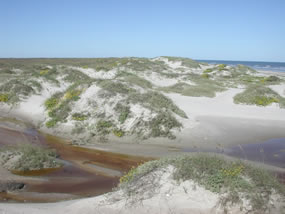 |
 | |
  | |
|
|
|
|
Padre Island National Seashore
Nature & Science
|
|
|
|
|
| |
 |
 |
| NPS photo by Phil Slattery | | Padre Island National Seashore near the 10 mile marker. |
 |
Padre Island National Seashore is the longest section of undeveloped barrier island in the world, protecting rare coastal prairie; a complex, dynamic dune system; and the Laguna Madre, one of the few hypersaline lagoon environments left in the world. The National Seashore and surrounding waters provide important habitat for marine and terrestrial plants and animals, including a number of rare, threatened, and endangered species. Situated along the Central Flyway, Padre Island is a globally important area for over 350 migratory, overwintering, and resident bird species. The National Seashore's remote location also makes it one of the few places where the public can find quiet and solitude relatively near a major urban area and where one can observe the night sky with minimal interference from light pollution. The National Seashore is also one of the few places the public can go to see sea turtle hatchlings being released into the wild.
Are you a scientist, a student doing research, or do you just want to know more about park research and the permiting system? Just follow this link for more information.
|
|  |  |
|
|

Learn about Research and Permits
link to site
more... | | 
Interpretive Programs
Learn more about this subject at one of the park's interpretive programs.
more... | |
|
|
|
|
|
|
|
 |
|
Did You Know?
The white-tailed deer on the island are not considered the island's largest native mammal, because they are believed to come across the Laguna Madre from the mainland? Coyotes are considered the island's largest native mammal.
more...
|
|
|
|
Last Updated: November 16, 2007 at 12:18 EST |






